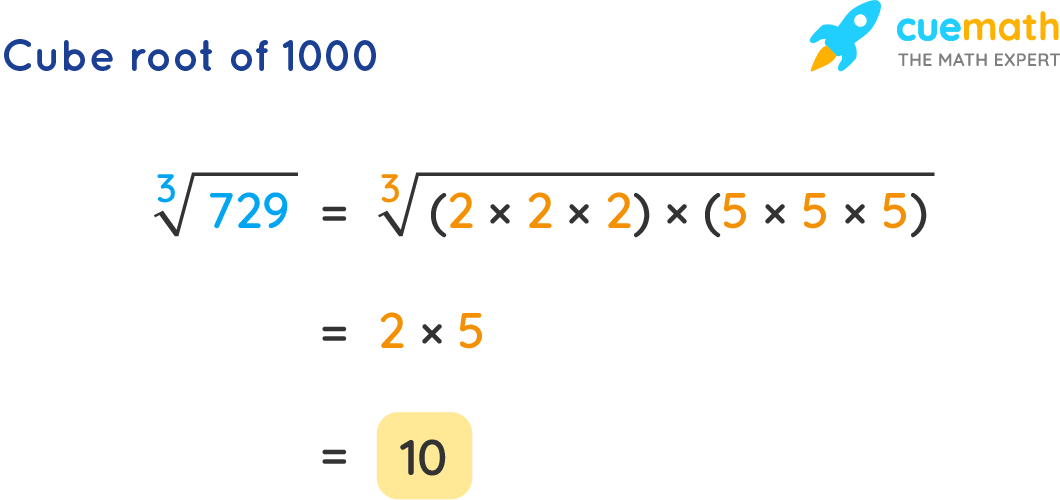Cube Root of 1000
The value of the cube root of 1000 is 10. It is the real solution of the equation x3 = 1000. The cube root of 1000 is expressed as ∛1000 in radical form and as (1000)⅓ or (1000)0.33 in the exponent form. As the cube root of 1000 is a whole number, 1000 is a perfect cube.
- Cube root of 1000: 10
- Cube root of 1000 in exponential form: (1000)⅓
- Cube root of 1000 in radical form: ∛1000

| 1. | What is the Cube Root of 1000? |
| 2. | How to Calculate the Cube Root of 1000? |
| 3. | Is the Cube Root of 1000 Irrational? |
| 4. | FAQs on Cube Root of 1000 |
What is the Cube Root of 1000?
The cube root of 1000 is the number which when multiplied by itself three times gives the product as 1000. Since 1000 can be expressed as 2 × 2 × 2 × 5 × 5 × 5. Therefore, the cube root of 1000 = ∛(2 × 2 × 2 × 5 × 5 × 5) = 10.
How to Calculate the Value of the Cube Root of 1000?
Cube Root of 1000 by Prime Factorization
- Prime factorization of 1000 is 2 × 2 × 2 × 5 × 5 × 5
- Simplifying the above expression: 23 × 53
- Simplifying further: 103
Therefore, the cube root of 1000 by prime factorization is (2 × 2 × 2 × 5 × 5 × 5)1/3 = 10.
Is the Cube Root of 1000 Irrational?
No, because ∛1000 = ∛(2 × 2 × 2 × 5 × 5 × 5) can be expressed in the form of p/q i.e. 10/1. Therefore, the value of the cube root of 1000 is an integer (rational).
☛ Also Check:
- Cube Root of 384
- Cube Root of 192
- Cube Root of 48
- Cube Root of 4096
- Cube Root of 243
- Cube Root of 392
- Cube Root of 36
Cube Root of 1000 Solved Examples
-
Example 1: Find the real root of the equation x3 − 1000 = 0.
Solution:
x3 − 1000 = 0 i.e. x3 = 1000
Solving for x gives us,
x = ∛1000, x = ∛1000 × (-1 + √3i))/2 and x = ∛1000 × (-1 - √3i))/2
where i is called the imaginary unit and is equal to √-1.
Ignoring imaginary roots,
x = ∛1000
Therefore, the real root of the equation x3 − 1000 = 0 is for x = ∛1000 = 10. -
Example 2: Given the volume of a cube is 1000 in3. Find the length of the side of the cube.
Solution:
Volume of the Cube = 1000 in3 = a3
⇒ a3 = 1000
Cube rooting on both sides,
⇒ a = ∛1000 in
Since the cube root of 1000 is 10, therefore, the length of the side of the cube is 10 in. -
Example 3: What is the value of ∛1000 ÷ ∛(-1000)?
Solution:
The cube root of -1000 is equal to the negative of the cube root of 1000.
⇒ ∛-1000 = -∛1000
Therefore,
⇒ ∛1000/∛(-1000) = ∛1000/(-∛1000) = -1

FAQs on Cube Root of 1000
What is the Value of the Cube Root of 1000?
We can express 1000 as 2 × 2 × 2 × 5 × 5 × 5 i.e. ∛1000 = ∛(2 × 2 × 2 × 5 × 5 × 5) = 10. Therefore, the value of the cube root of 1000 is 10.
What is the Value of 10 Plus 7 Cube Root 1000?
The value of ∛1000 is 10. So, 10 + 7 × ∛1000 = 10 + 7 × 10 = 80. Hence, the value of 10 plus 7 cube root 1000 is 80.
What is the Cube of the Cube Root of 1000?
The cube of the cube root of 1000 is the number 1000 itself i.e. (∛1000)3 = (10001/3)3 = 1000.
What is the Cube Root of -1000?
The cube root of -1000 is equal to the negative of the cube root of 1000. Therefore, ∛-1000 = -(∛1000) = -(10) = -10.
Is 1000 a Perfect Cube?
The number 1000 on prime factorization gives 2 × 2 × 2 × 5 × 5 × 5. On combining the prime factors in groups of 3 gives 10. So, the cube root of 1000 = ∛(2 × 2 × 2 × 5 × 5 × 5) = 10 (perfect cube).
How to Simplify the Cube Root of 1000/27?
We know that the cube root of 1000 is 10 and the cube root of 27 is 3. Therefore, ∛(1000/27) = (∛1000)/(∛27) = 10/3 = 3.3333.
visual curriculum